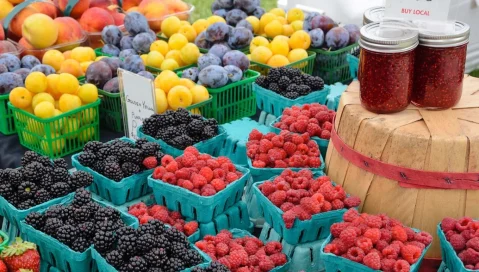Why Farm-to-Fork Transparency Is Essential for Food and Beverage Manufacturers
Why Farm-to-Fork Transparency Is Essential for Food and Beverage Manufacturers
Why Farm-to-Fork Transparency Is Essential for Food and Beverage Manufacturers
26 Juli 2022
Jack Payne
Expectations for clear and effective communication with consumers and regulatory agencies are ramping up in the food and beverage world. While nutritional information and ingredient lists on product packaging may have been considered sufficient in the past, now brands must ensure complete farm-to-fork transparency if they’re to succeed.
In fact, the European Union has gone so far as to make it a legal requirement—the Farm to Fork Strategy, which is part of the European Green Deal, centers on how transparency can make the industry more sustainable and includes goals for mitigating climate change and loss of biodiversity, as well as other provisions.
But it’s not just EU-based businesses that are facing pressure to be more open and accountable about the origin, movement and usage of materials all along the supply chain. The demand exists around the globe, and there are several good reasons behind the increased importance being placed on this particular area of operations.
Read on to learn why farm-to-fork transparency is absolutely essential for food and beverage manufacturers, as well as how enterprise resource planning (ERP) technology can help your company meet the higher standards of today’s competitive marketplace.
Regulatory Compliance
The aforementioned Farm to Fork Strategy consists of a legislative framework for sustainable food systems, and the European Commission has also committed to creating a contingency plan for ensuring food supply and security to be rolled out later. Among the specific requirements are cutting back on pesticides and antimicrobials by 50% and fertilizers by 20% while increasing farmland under organic practices by 25%.
Meanwhile, in the U.S., the Food and Drug Administration (FDA) is preparing to officially put the Proposed Rule for Food Traceability in place as a key part of the New Era of Smarter Food Safety. This addition to current regulations establishes a 16-item Food Traceability List of the most problematic ingredients, as well as the critical concepts of Key Data Elements and Critical Tracking Events to ensure the necessary level of detail is captured in supply chain management.
Avoiding the negative ramifications of being found in violation of these and other regulations is no doubt a primary motivating factor for ensuring transparency, as you naturally want to keep fines and penalties to an absolute minimum while also safeguarding against any temporary or permanent closures of your facilities. Consider, too, the potential damage to your brand reputation should your name end up in the headlines for the wrong reasons, and due diligence on this front becomes all the more vital.
Product Quality and Safety
Transparency and food traceability go hand in hand—after all, you can’t share information that you don’t have, and that means that you must track all of your raw ingredients and finished goods bilaterally along the supply chain to fulfill your responsibilities in this regard. The effort will be well worth it, as following best practices can unlock the additional benefits of more consistently excellent product quality and uncompromising food safety.
With full visibility into where your materials come from, how long they spend in transit and their freshness at various stages of the journey, you can successfully stay ahead of issues that might hamper the viability of the items you produce. The insight you gain will help you make sure you’re using only the best components for your products, making the end consumer’s experience enjoyable and satisfying.
Being able to trace and isolate contaminations is also a key advantage to be gained through greater transparency, as complete data will make the process more streamlined and accurate. You’ll also be more recall-ready, able to quickly identify goods that have been affected and released downstream for swift withdrawal and disposal while also issuing all important notifications to relevant parties.
of people are more likely to stay loyal to brands that are completely transparent
Appeal to Conscious Consumers
You likely know well just how tough it can be to rise to the top of any given sector in the wider food and beverage industry—it requires differentiating your organization from competitors and meeting consumers’ demands better than other brands. Greater transparency can be how you accomplish those aims, as more and more shoppers today are looking for companies that communicate openly and honestly.
For proof, take the label insight survey conducted by Nielsen that revealed 94% of people are more likely to stay loyal to brands that are completely transparent, and 73% are willing to pay more for products that are marketed with complete transparency. Innova Market Insights also found that 6 in 10 global consumers are interested in learning more about where their food comes from, demonstrating the value in disclosing all pertinent information to your customers.
If your business strives to make transparency a key differentiator, it can serve as a pillar on which you build a solid brand reputation. Being known for fair and fully disclosed practices can be a huge boon for your bottom line, as consumers who consider themselves more conscious of their habits and how they affect the environment and broader society will learn your name as one to trust in the product segment you serve.
How the Right ERP Can Help You Meet Transparency Demands
At Aptean, we champion ERP software as the best foundation for a digital transformation, and that’s in part due to the fact that these solutions help you maintain total transparency both internally and externally. By having a single, unified system that stores and updates all of your data, you can drill down into material and product details in no time and make sure that relevant information is conveyed to enforcement agencies and consumers alike.
What’s more, an ERP built for food and beverage businesses—like our own industry-specific food and beverage solution, Aptean Food & Beverage ERP—come with purpose-built tools for maintaining compliance based on your region, complete traceability forward and backward along the supply chain, quality assurance and food safety. We’ve even included modules dedicated to the packaging and labeling of your goods so that you can satisfy shoppers’ expectations for clear communication.
Better still, our offering can be deployed from the cloud on a software as a service (SaaS) model to maximize your flexibility and mobile accessibility while keeping up-front hardware costs to a minimum. Such an implementation also provides excellent security and 99.9% uptime thanks to our reliable and dedicated teams of IT professionals.
Finally, Aptean’s food ERP shines thanks to its robust and unique industry-specific technology built on an underlying Microsoft Dynamics 365 Business Central platform. Any of your employees familiar with other Microsoft programs and applications will find themselves at home working in the system, as the interface is user-friendly and highly approachable.
So, ready to hear more about how Aptean Food & Beverage ERP can help your company deliver according to the transparency demands of today? Contact us or request a personalized demo.
How To Thrive During Food and Beverage Market Turbulence
Prioritizing modernization, optimization and a sound strategy is necessary for success in the food and beverage industry. Increase operational agility in a continually changing (and often unpredictable) manufacturing landscape.



